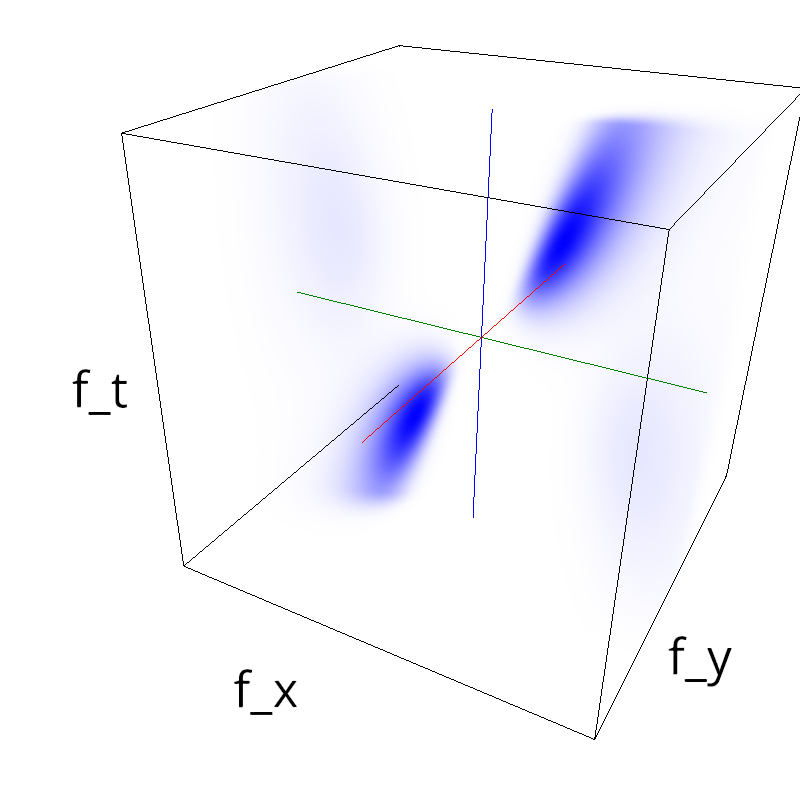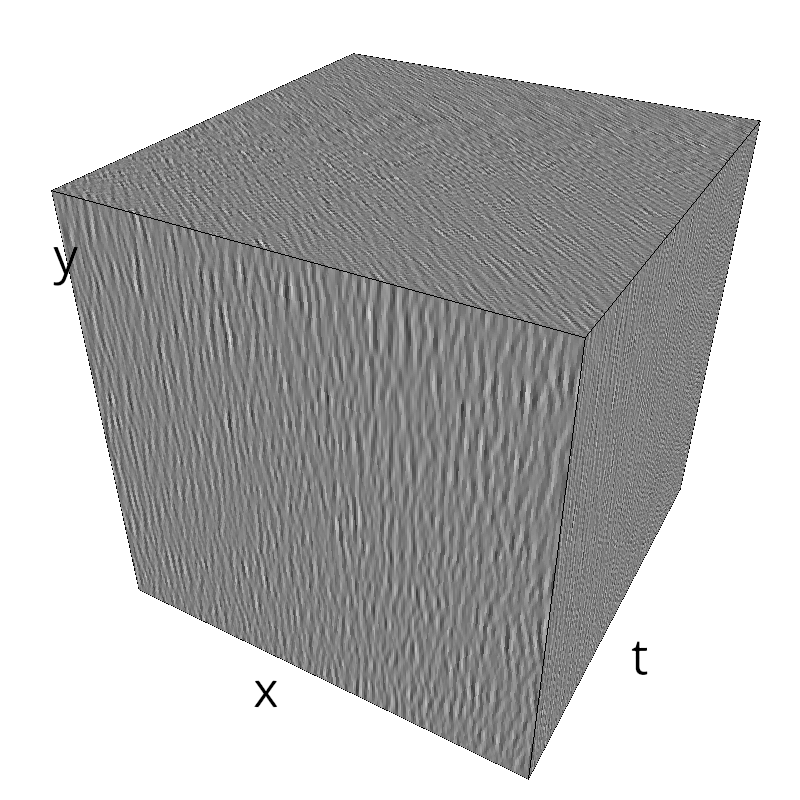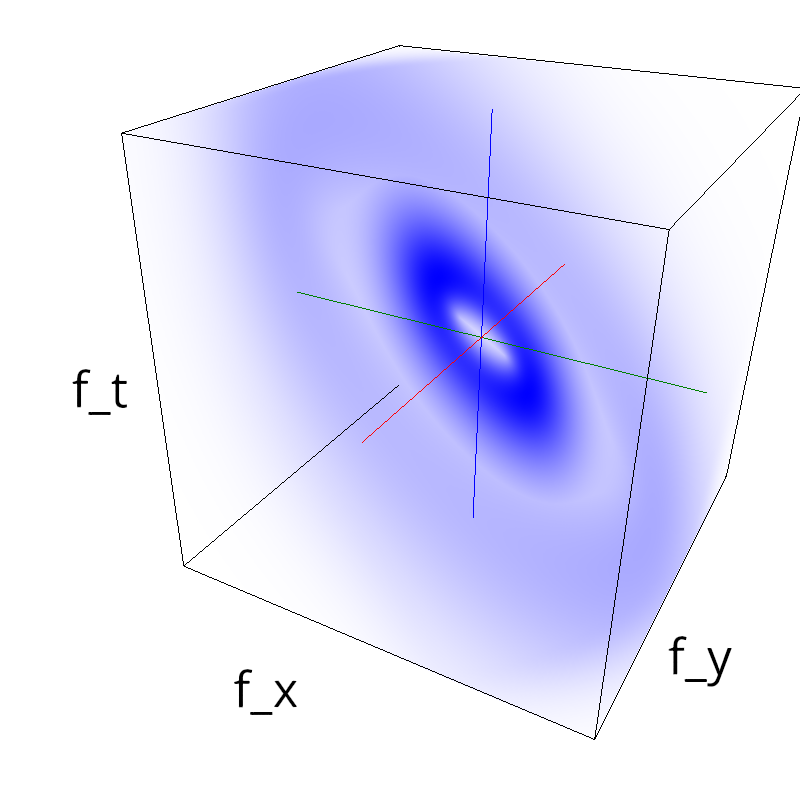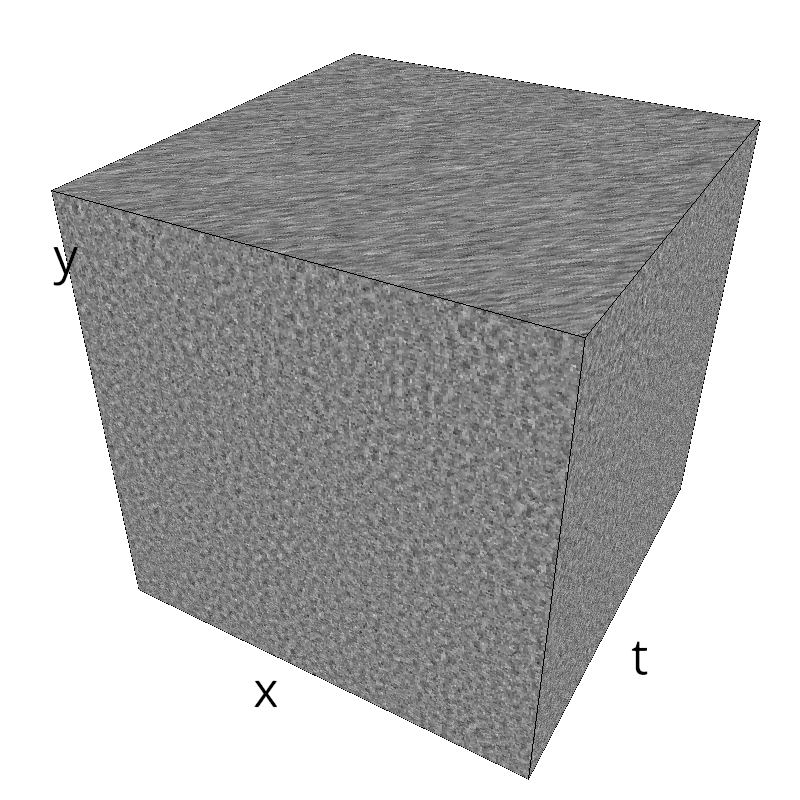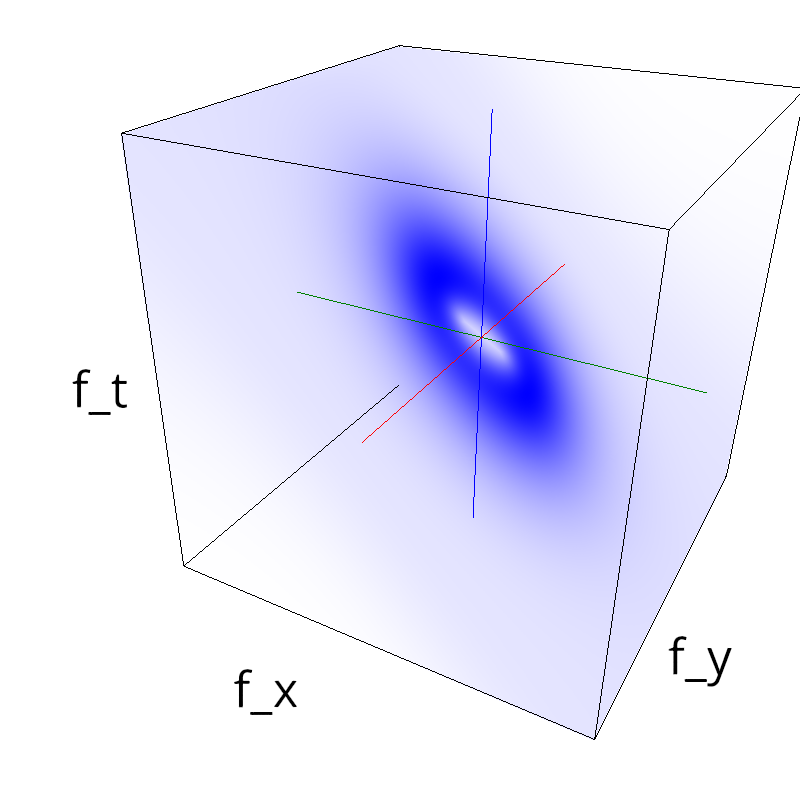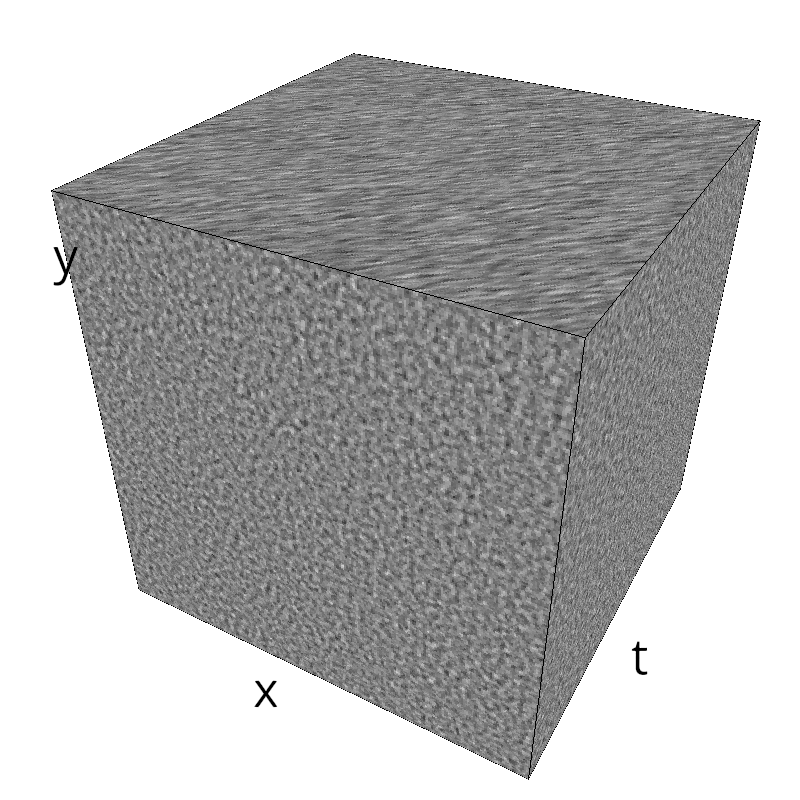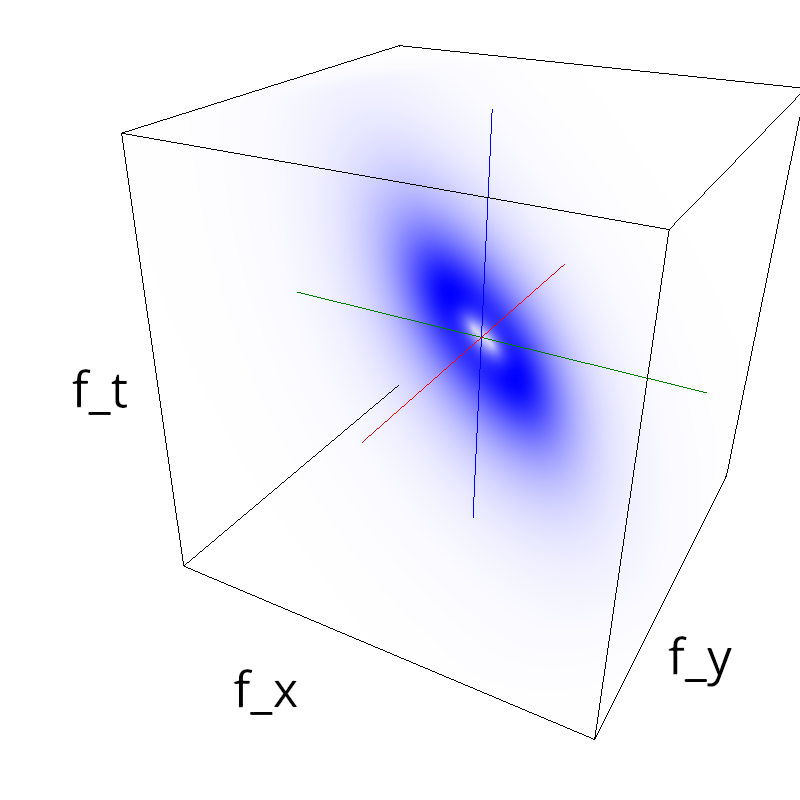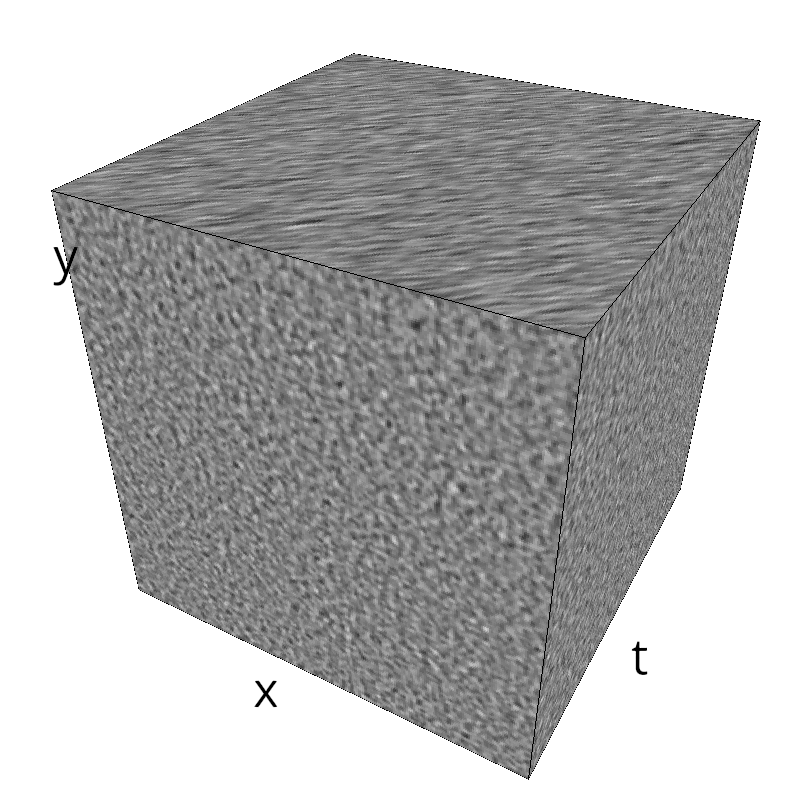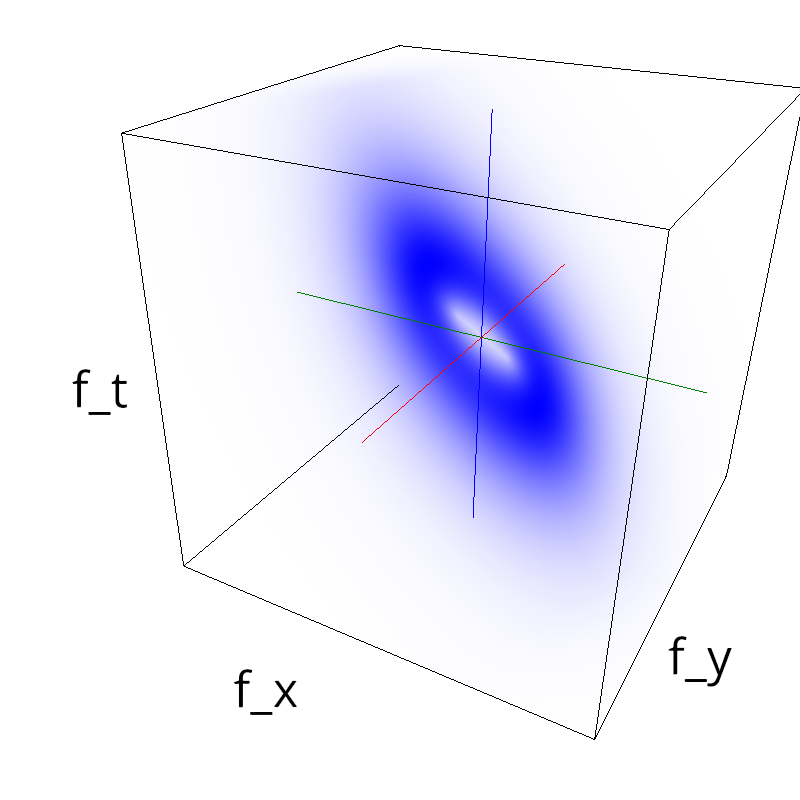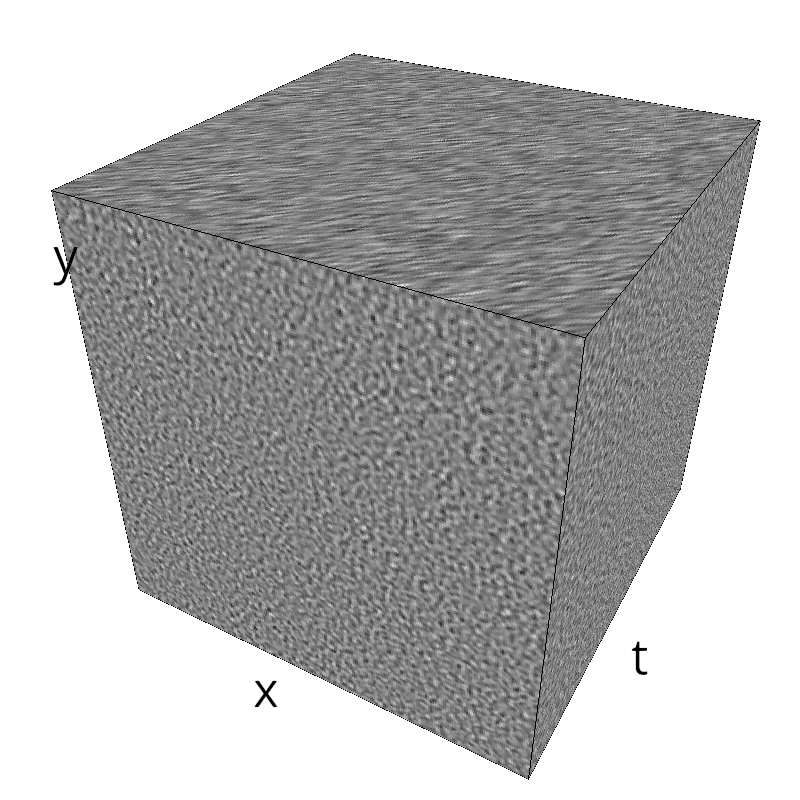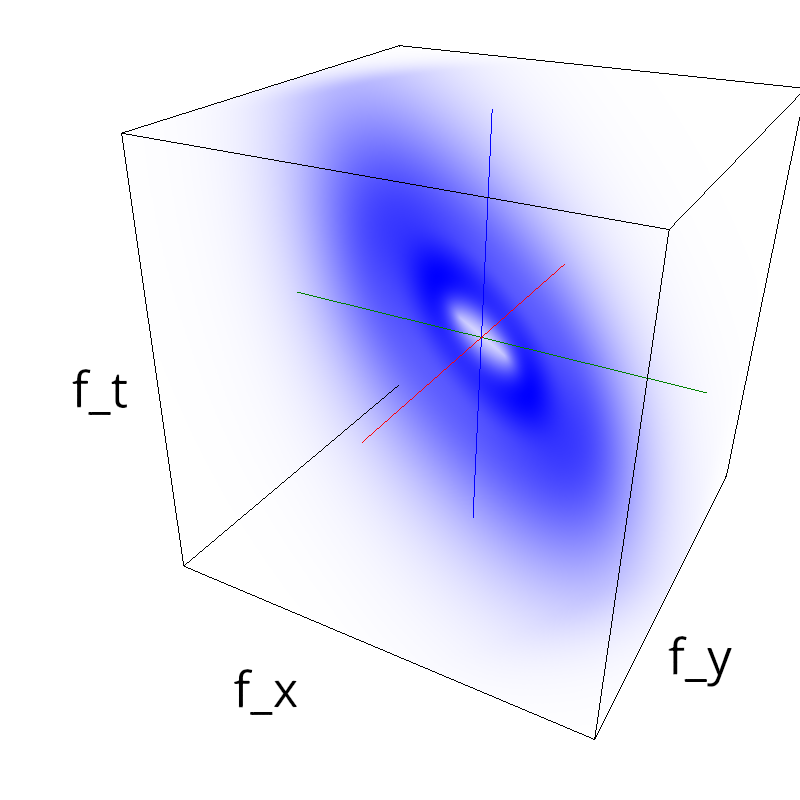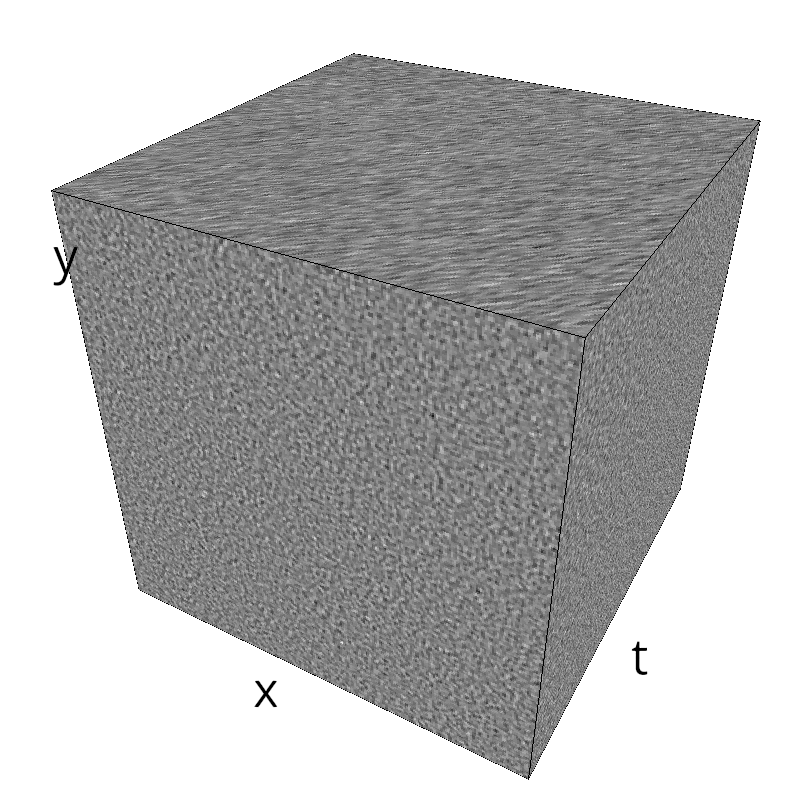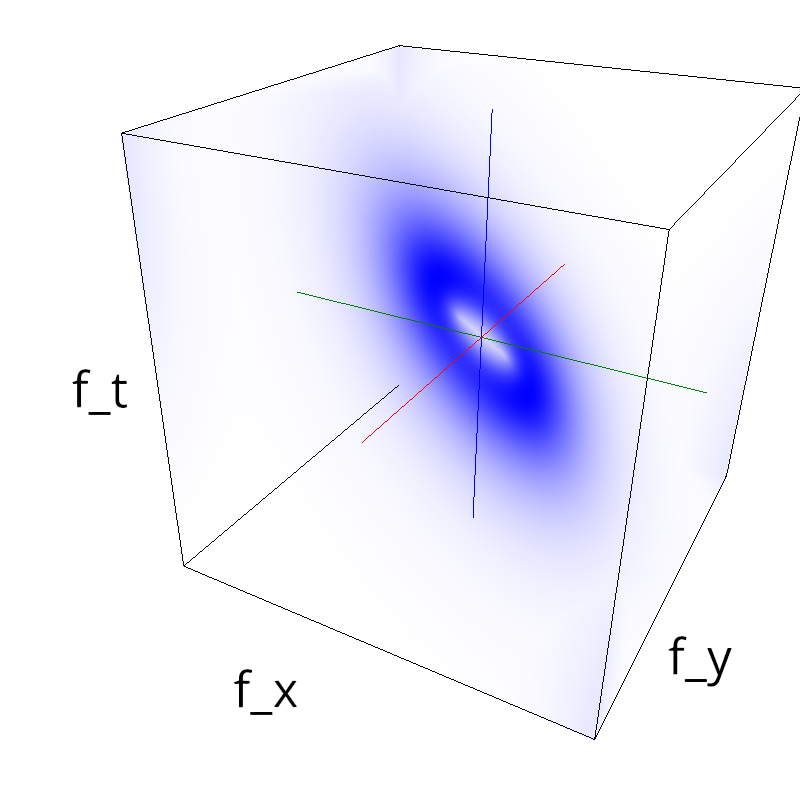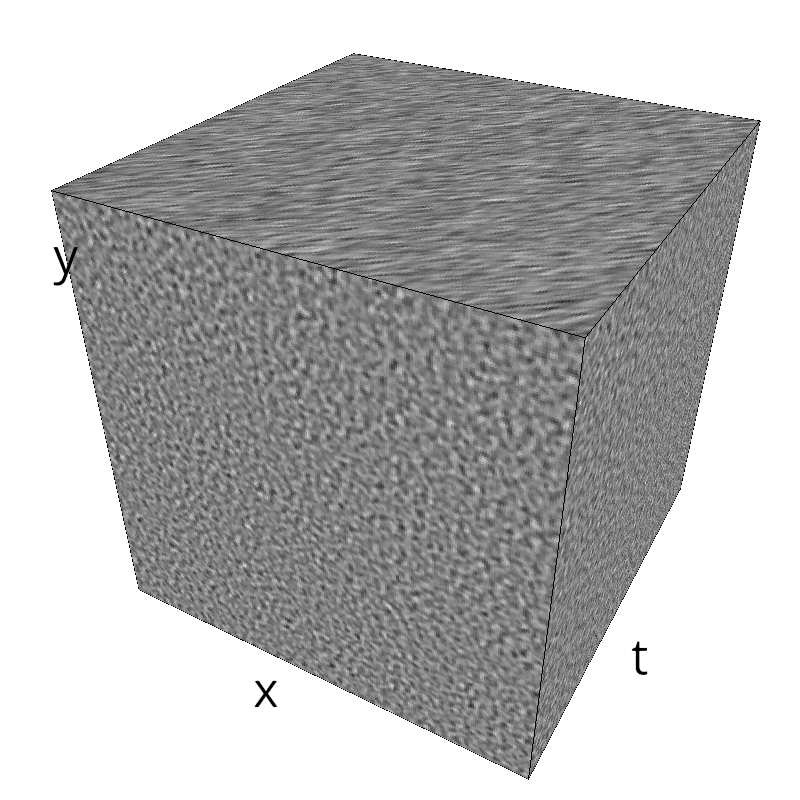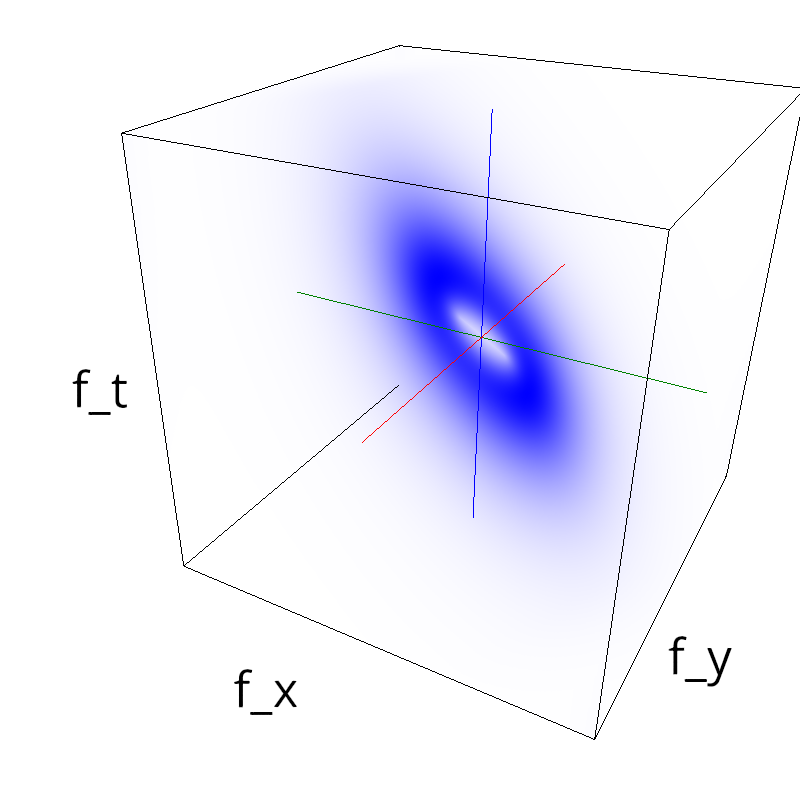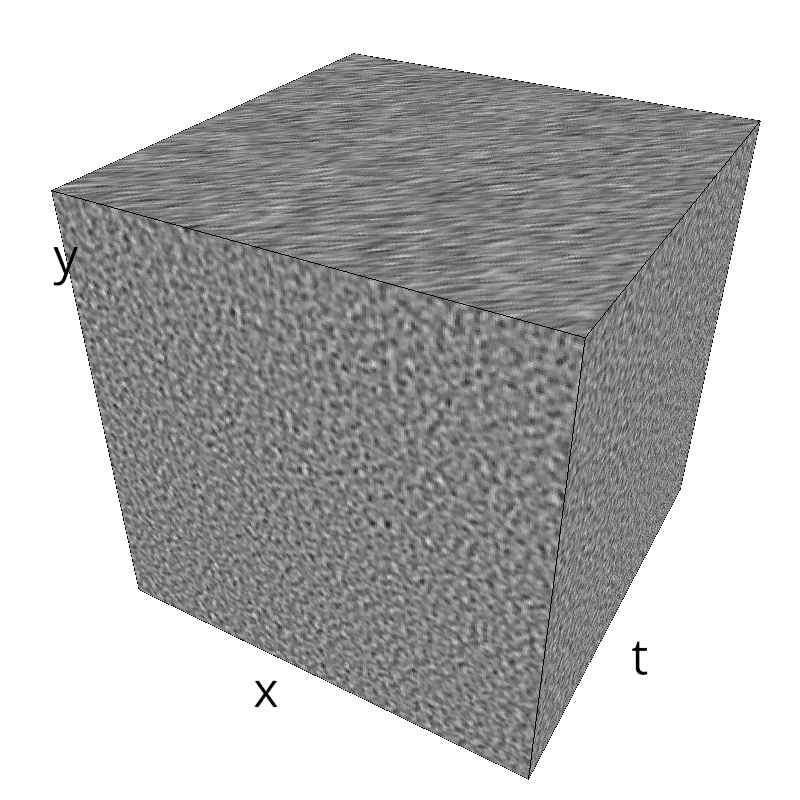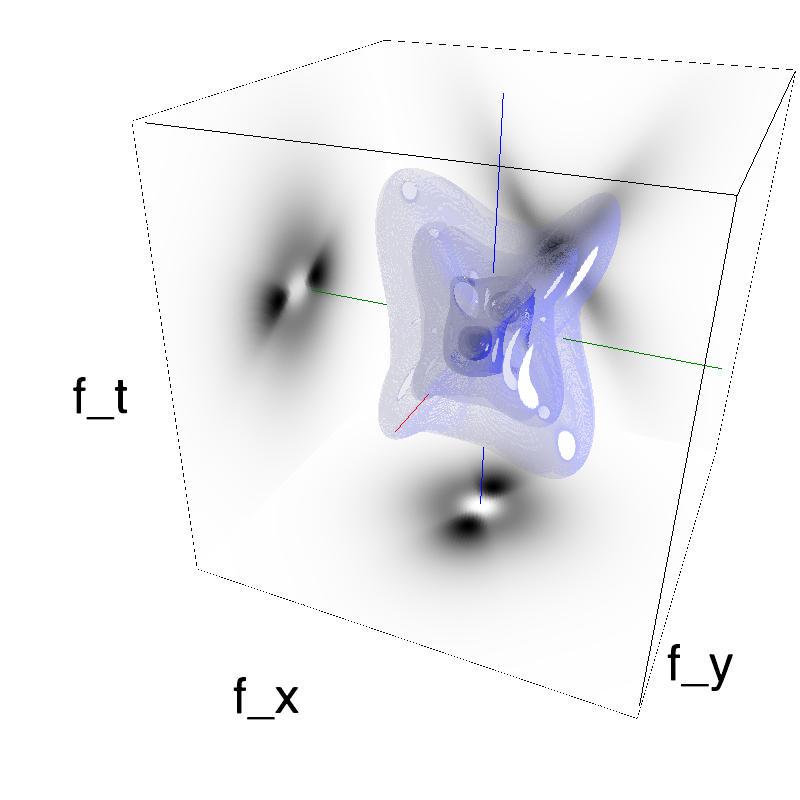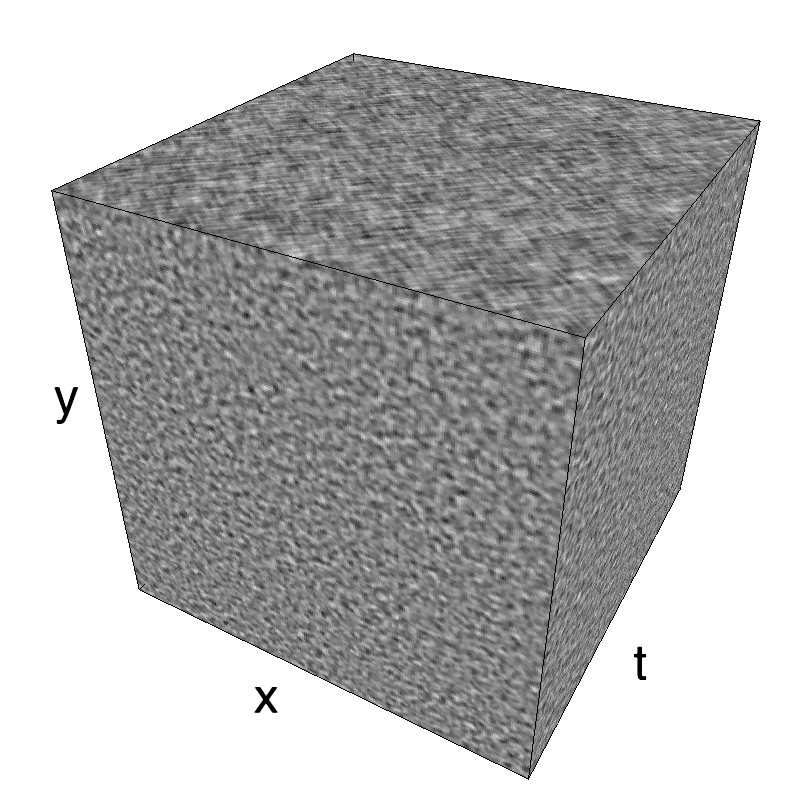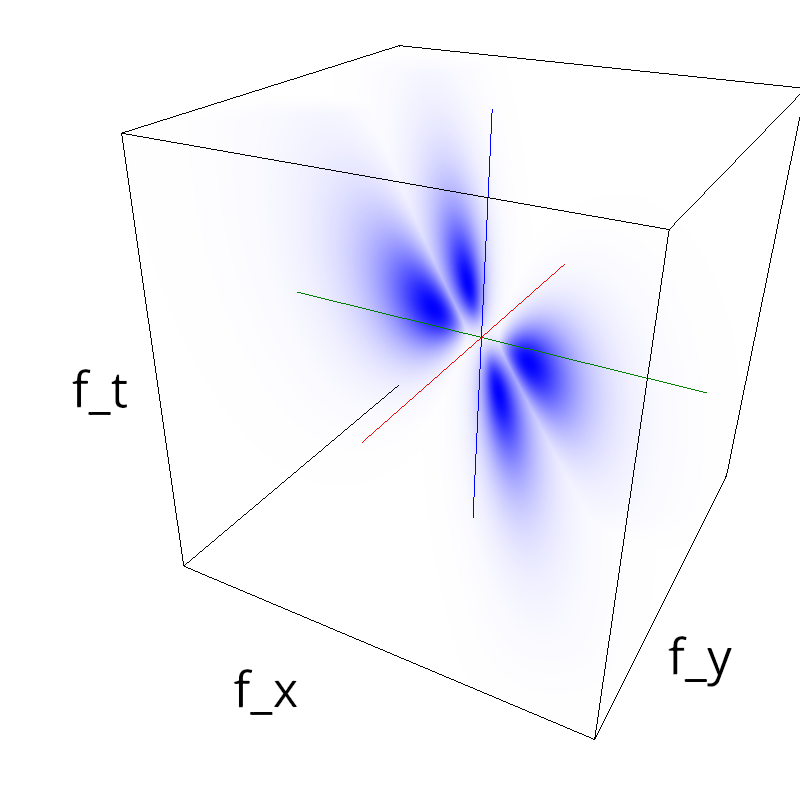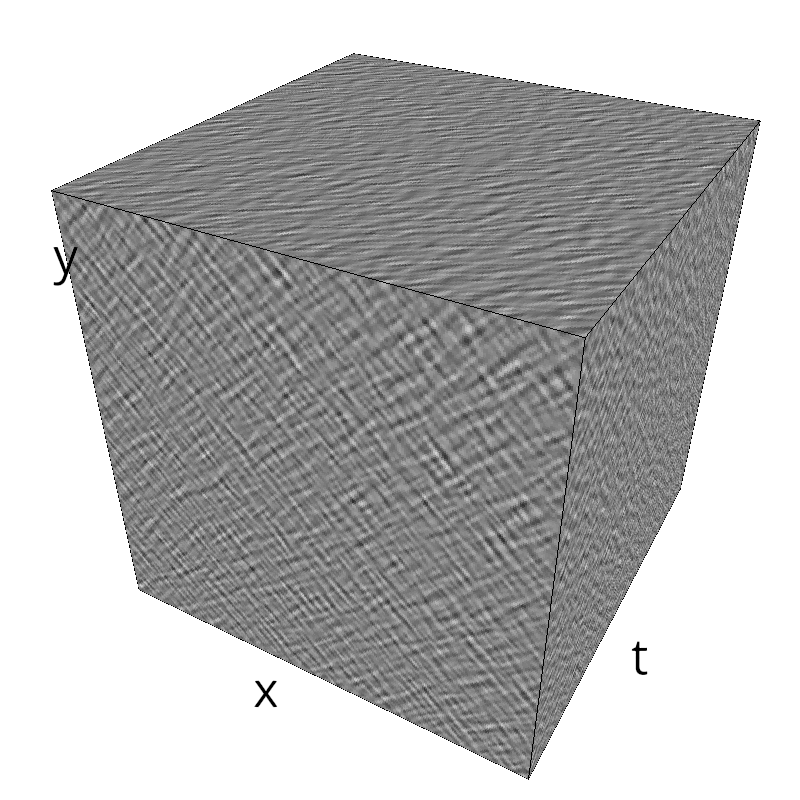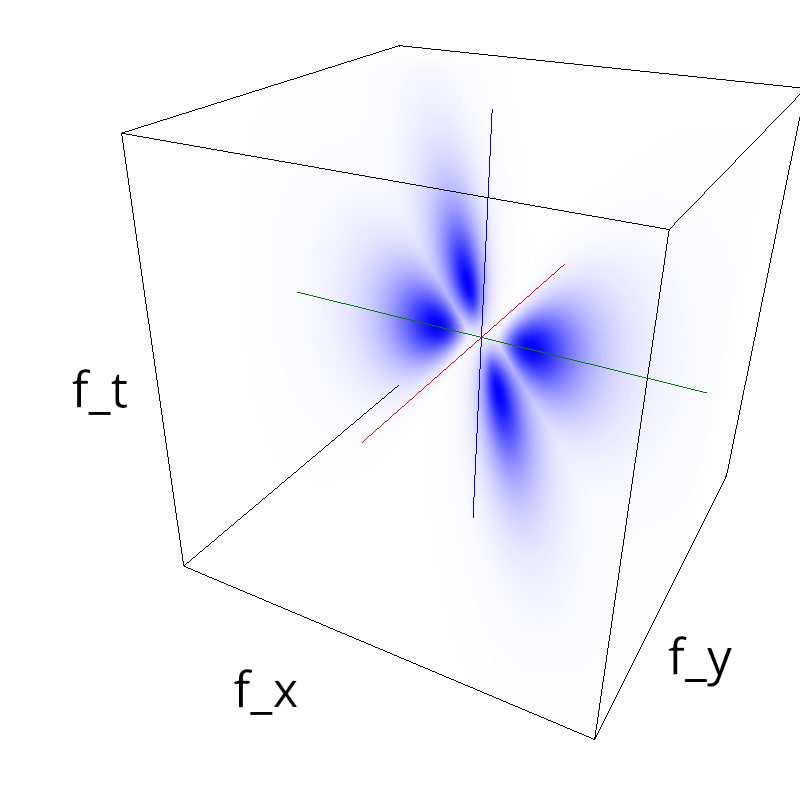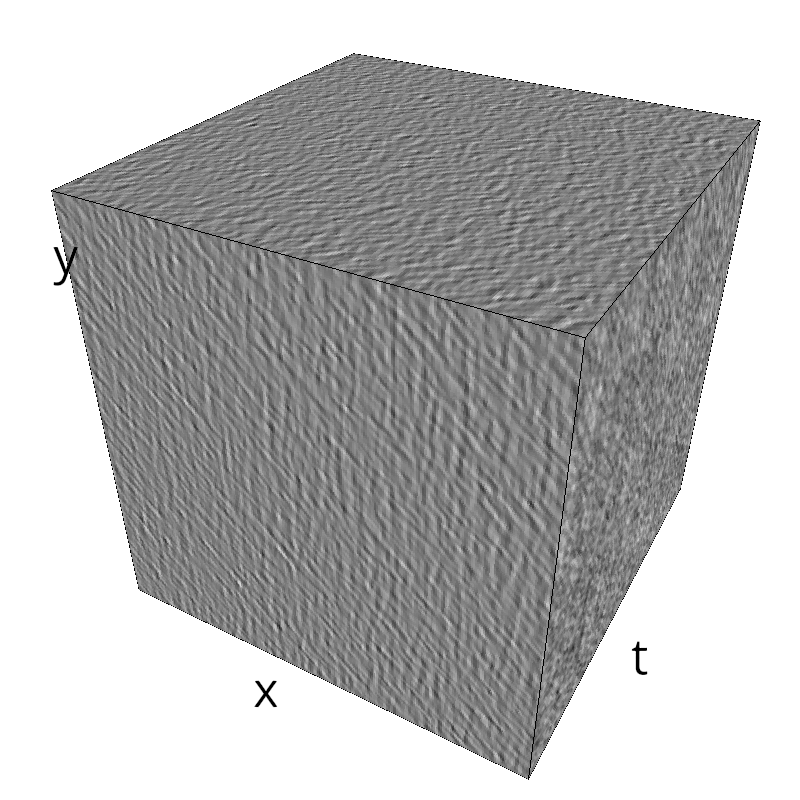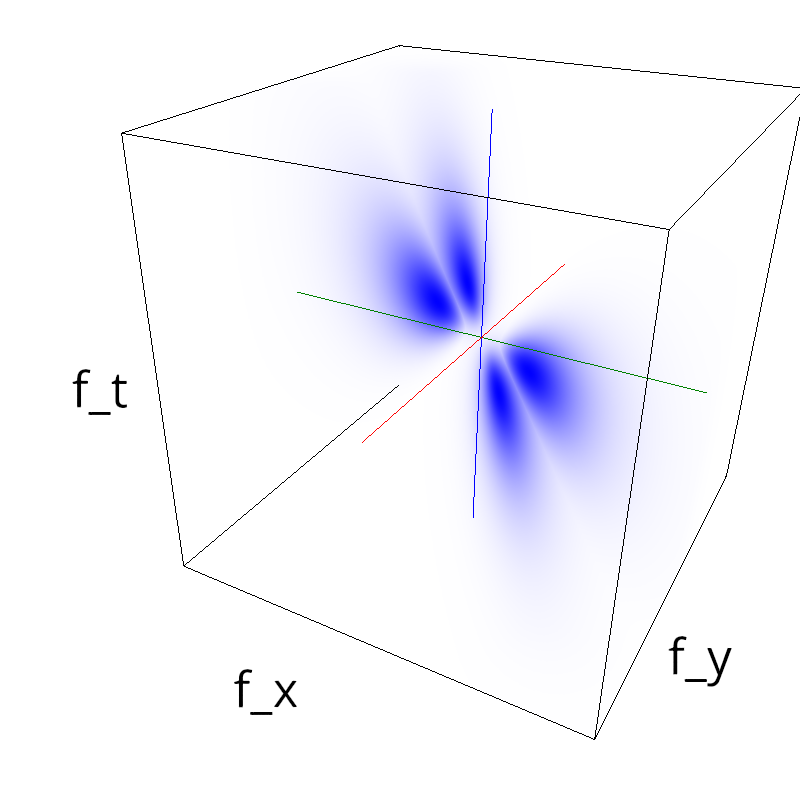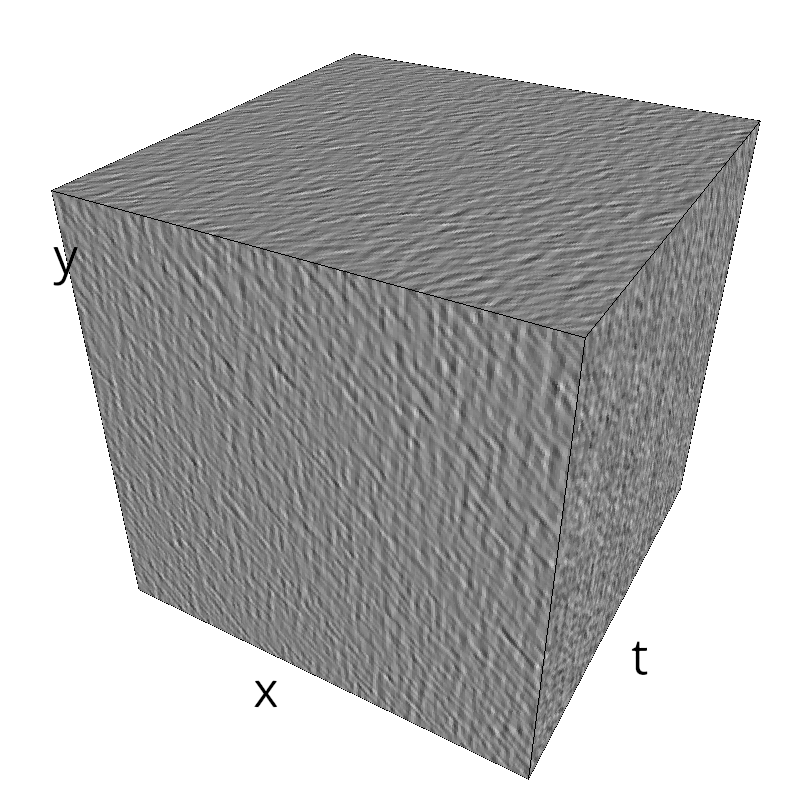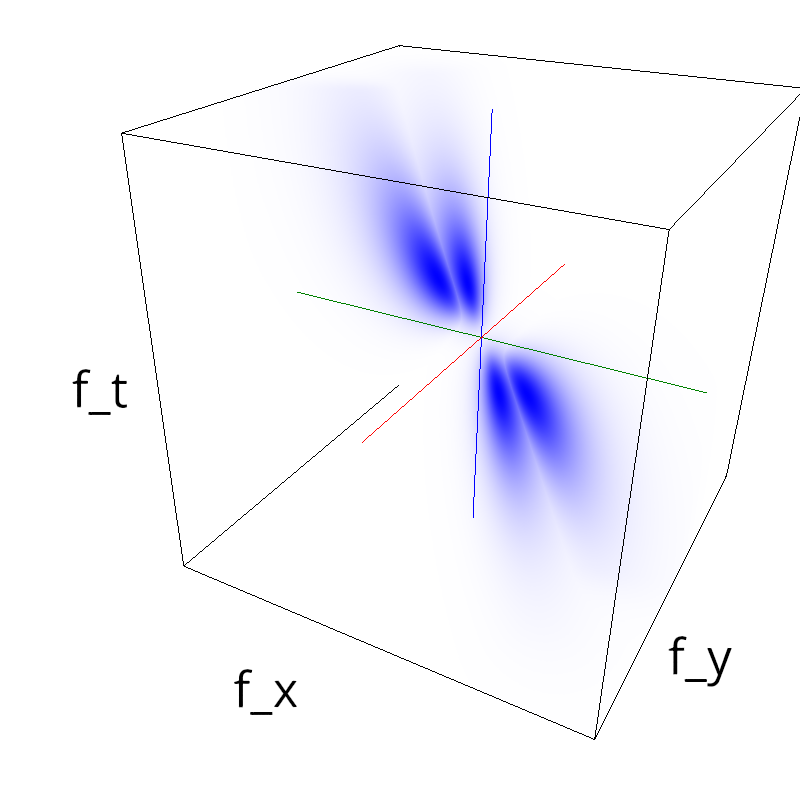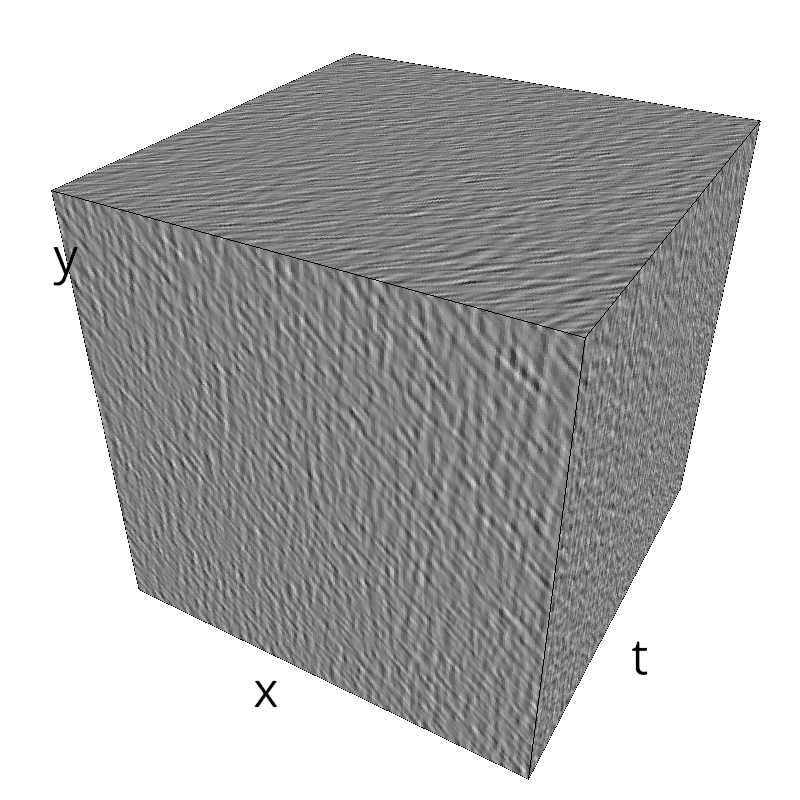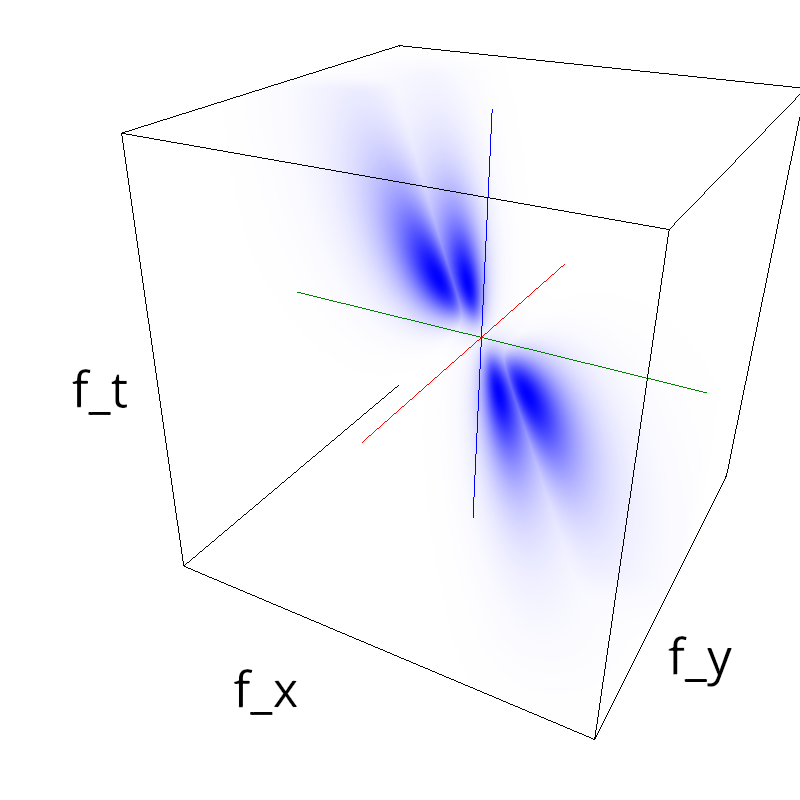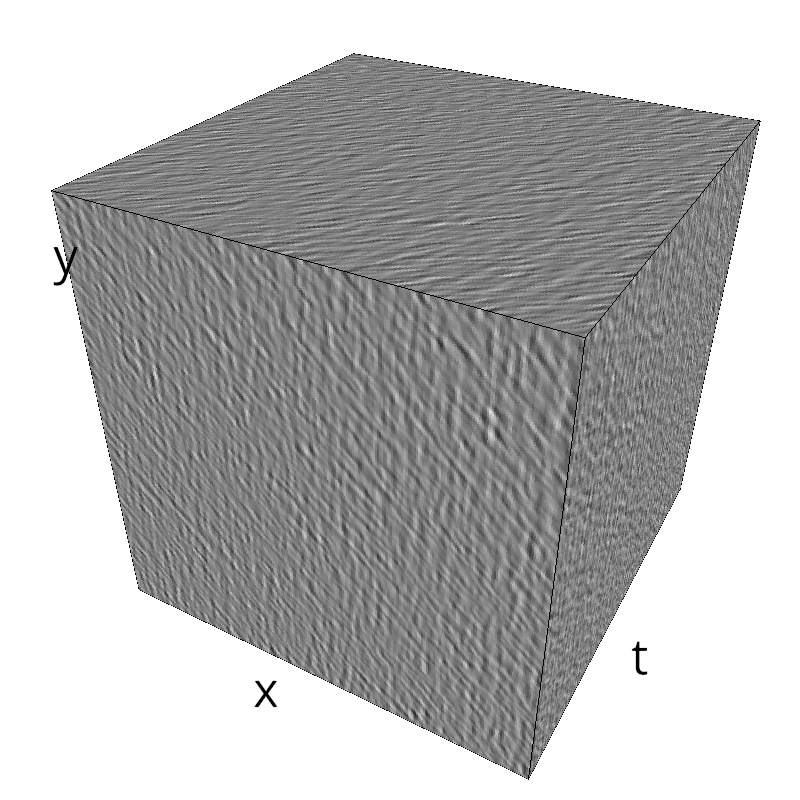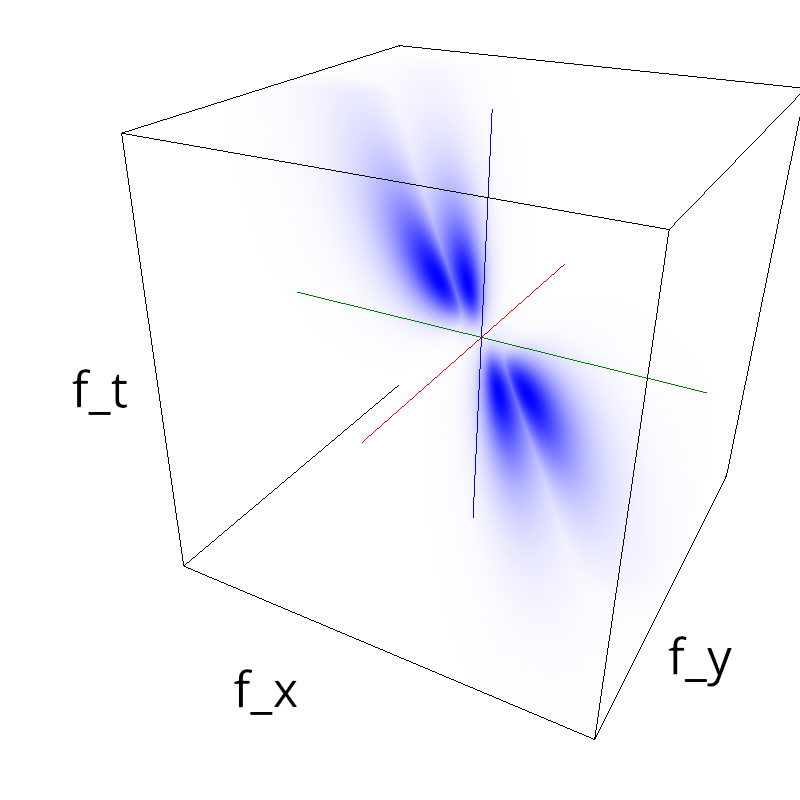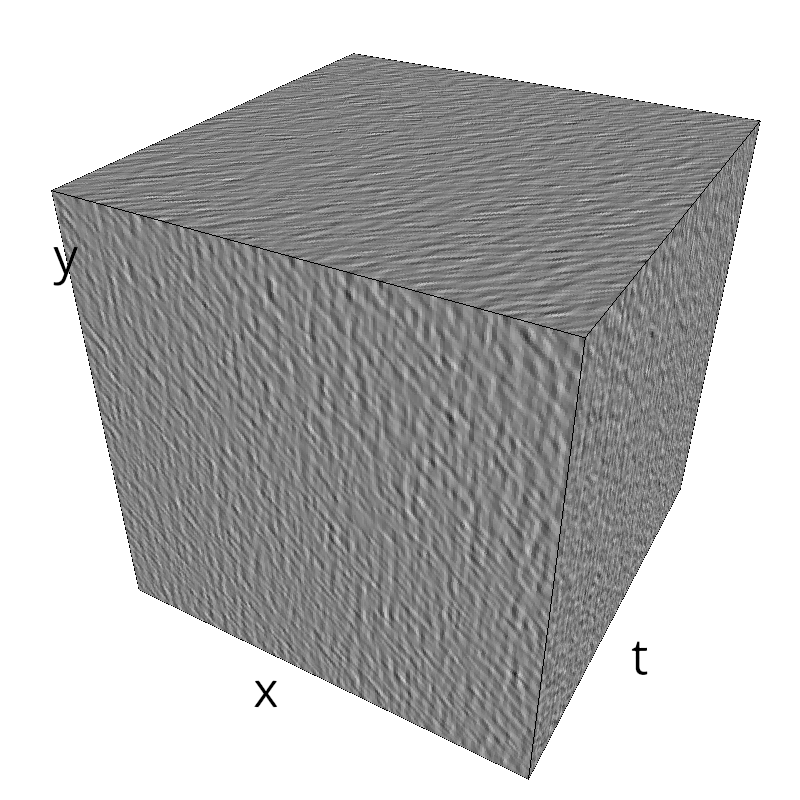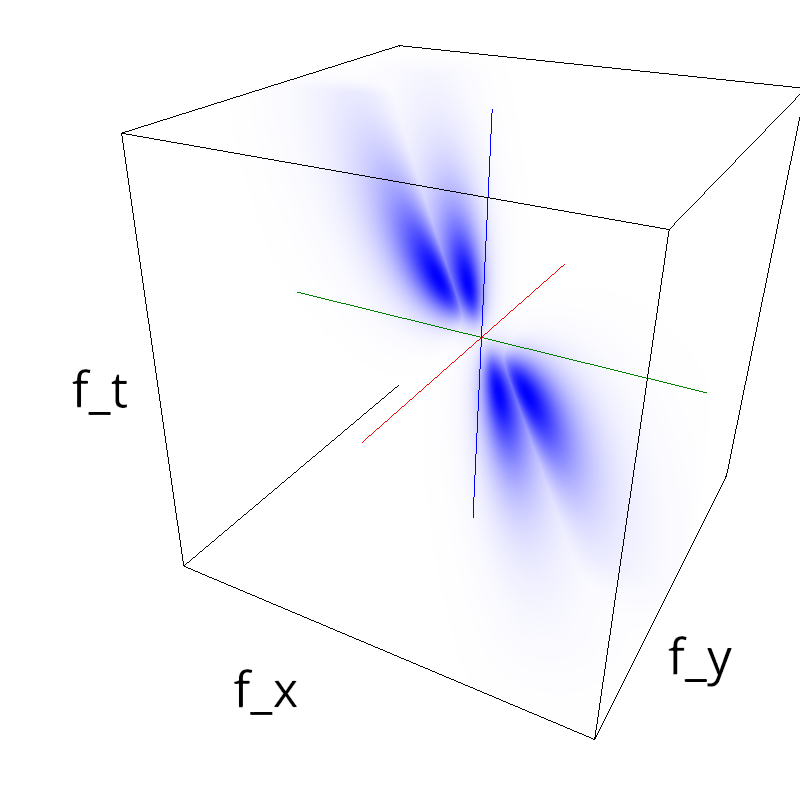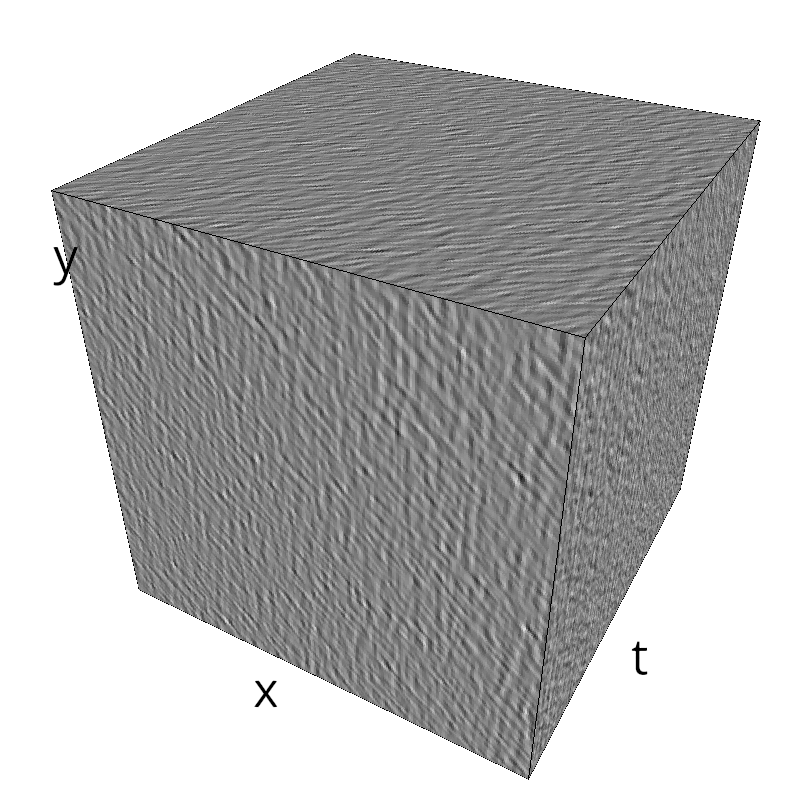Testing competing Motion Clouds with psychopy
A Discrimination Experiment: Competing MCs¶
A nice feature of MCs is the ability to superpose them without much interference. Indeed, summing two gratings generates intereference patterns (Moiré or plaids) which are interfering with the sensory processes that we study. On the contrary, MotionClouds are defined as uncoherent textures and interefrences are just happening "by chance".
%%writefile ../files/experiment_competing.py
#!/usr/bin/env python
"""
Superposition of MotionClouds to generate competing motions.
(c) Laurent Perrinet - INT/CNRS
"""
import numpy
import MotionClouds as mc
fx, fy, ft = mc.get_grids(mc.N_X, mc.N_Y, mc.N_frame)
name = 'competing'
z = (.5*mc.envelope_gabor(fx, fy, ft, sf_0=0.2, V_X=-1.5)
+ .1*mc.envelope_gabor(fx, fy, ft, sf_0=0.4, V_X=.5)#, theta=numpy.pi/2.)
)
mc.figures(z, name)
mc.in_show_video(name)
name = 'two_bands'
# and now selecting blobs:
# one band
one = mc.envelope_gabor(fx, fy, ft, B_theta=10.)
# a second band
two = mc.envelope_gabor(fx, fy, ft, sf_0=.45, B_theta=10.)
mc.figures(one + two, name)
mc.in_show_video(name)
# explore parameters
for sf_0 in [0.0, 0.1 , 0.2, 0.3, 0.8, 0.9]:
name_ = name + '-sf_0' + str(sf_0).replace('.', '_')
one = mc.envelope_gabor(fx, fy, ft, B_theta=10.)
two = mc.envelope_gabor(fx, fy, ft, sf_0=sf_0, B_theta=10.)
mc.figures(one + two, name_)
mc.in_show_video(name_)
name = 'counterphase_grating'
right = mc.envelope_speed(fx, fy, ft, V_X=.5 )
left = mc.envelope_speed(fx, fy, ft, V_X=-.5 )
grating = mc.envelope_gabor(fx, fy, ft)
z = grating * (left + right ) # thanks to the addititivity of MCs
mc.figures(z, name)
mc.in_show_video(name)
name = 'plaid'
diag1 = mc.envelope_gabor(fx, fy, ft, theta=numpy.pi/4.)
diag2 = mc.envelope_gabor(fx, fy, ft, theta=-numpy.pi/4.)
z = (diag1 + diag2)
mc.figures(z, name)
mc.in_show_video(name)
# explore parameters
for V_X in [0., 0.5, 1.]:
name_ = name + '-V_X' + str(V_X).replace('.', '_')
diag = mc.envelope_gabor(fx, fy, ft, V_X=V_X)
z = (diag + diag2)
mc.figures(z, name_)
mc.in_show_video(name_)
for V_Y in [0., 0.5, 1.]:
name_ = name + '-V_Y' + str(V_Y).replace('.', '_')
diag = mc.envelope_gabor(fx, fy, ft, V_Y=V_Y)
z = (diag + diag2)
mc.figures(z, name_)
mc.in_show_video(name_)
for div in [1, 2, 3, 5, 8, 13 ]:
name_ = name + '-theta_pi-over-' + str(div).replace('.', '_')
z = (mc.envelope_gabor(fx, fy, ft, theta=numpy.pi/div) + mc.envelope_gabor(fx, fy, ft, theta=-numpy.pi/div))
mc.figures(z, name_)
mc.in_show_video(name)
%cd ../files
%run experiment_competing.py
%cd ../posts
%%writefile ../files/psychopy_simple.py
#!/usr/bin/env python
"""
A basic presentation in psychopy
(c) Laurent Perrinet - INT/CNRS
"""
# width and height of your screen
w, h = 1920, 1200
w, h = 2560, 1440
# width and height of the stimulus
w_stim, h_stim = 1024, 1024
loops = 1
import MotionClouds as mc
fx, fy, ft = mc.get_grids(mc.N_X, mc.N_Y, mc.N_frame)
env = (mc.envelope_gabor(fx, fy, ft, V_X=1.) + mc.envelope_gabor(fx, fy, ft, V_X=-1.))
z = 2*mc.rectif(mc.random_cloud(env), contrast=.5) -1.
#from pyglet.gl import gl_info
from psychopy import visual, core, event, logging
logging.console.setLevel(logging.DEBUG)
win = visual.Window([w, h], fullscr=True)
stim = visual.GratingStim(win,
size=(w_stim, h_stim), units='pix',
interpolate=True,
mask='gauss',
autoLog=False)#this stim changes too much for autologging to be useful
for i_frame in range(mc.N_frame * loops):
#creating a new stimulus every time
stim.setTex(z[:, :, i_frame % mc.N_frame])
stim.draw()
win.flip()
win.close()
%cd ../files
!python2 psychopy_simple.py
%cd ../posts
We may now test what motion is detected when superposing 2 MCs:
%%writefile ../files/psychopy_competing.py
#!/usr/bin/env python
"""
Using psychopy to perform an experiment on competing clouds
(c) Laurent Perrinet - INT/CNRS
See http://www.motionclouds.invibe.net/posts/instructions-for-psychophysicists.html for a small tutorial
"""
# width and height of your screen
w, h = 1920, 1200
w, h = 2560, 1440 # iMac 27''
# width and height of the stimulus
w_stim, h_stim = 1024, 1024
print('launching experiment')
from psychopy import visual, core, event, logging, misc
logging.console.setLevel(logging.DEBUG)
import os, numpy
import MotionClouds as mc
import time, datetime
experiment = 'competing_v2_'
print('launching experiment')
logging.console.setLevel(logging.DEBUG)
#if no file use some defaults
info = {}
info['observer'] = 'anonymous'
info['screen_width'] = w
info['screen_height'] = h
info['nTrials'] = 5
info['N_X'] = mc.N_X # size of image
info['N_Y'] = mc.N_Y # size of image
info['N_frame_total'] = 64 # a full period. in time frames
info['N_frame'] = 64 # length of the presented period. in time frames
info['timeStr'] = datetime.datetime.now().date().isoformat() + time.strftime("_%H%M", time.localtime())
fileName = 'data/' + experiment + info['observer'] + '_' + info['timeStr'] + '.pickle'
print('generating data')
fx, fy, ft = mc.get_grids(info['N_X'], info['N_Y'], info['N_frame_total'])
up = 2*mc.rectif(mc.random_cloud(mc.envelope_gabor(fx, fy, ft, V_X=+.5))) - 1
down = 2*mc.rectif(mc.random_cloud(mc.envelope_gabor(fx, fy, ft, V_X=-.5))) - 1
print('go! ')
win = visual.Window([info['screen_width'], info['screen_height']], fullscr=True)
stim = visual.GratingStim(win,
size=(info['screen_height'], info['screen_height']), units='pix',
interpolate=True,
mask = 'gauss',
autoLog=False)#this stim changes too much for autologging to be useful
wait_for_response = visual.TextStim(win,
text = u"?", units='norm', height=0.15, color='DarkSlateBlue',
pos=[0., -0.], alignHoriz='center', alignVert='center' )
wait_for_next = visual.TextStim(win,
text = u"+", units='norm', height=0.15, color='BlanchedAlmond',
pos=[0., -0.], alignHoriz='center', alignVert='center' )
def getResponse():
event.clearEvents()#clear the event buffer to start with
resp = None#initially
while 1:#forever until we return a keypress
for key in event.getKeys():
#quit
if key in ['escape', 'q']:
win.close()
core.quit()
return None
#valid response - check to see if correct
elif key in ['down', 'up']:
if key in ['down'] :return -1
else: return 1
else:
print( "hit DOWN or UP (or Esc) (You hit %s)" %key)
clock = core.Clock()
FPS = 50.
def presentStimulus(C_A, C_B):
"""Present stimulus
"""
phase_up = numpy.floor(numpy.random.rand() *(info['N_frame_total']-info['N_frame']))
phase_down = numpy.floor(numpy.random.rand() *(info['N_frame_total']-info['N_frame']))
clock.reset()
for i_frame in range(info['N_frame']): # length of the stimulus
stim.setTex(C_A * up[:, :, i_frame+phase_up]+C_B * down[:, :, i_frame+phase_down])
stim.draw()
# while clock.getTime() < i_frame/FPS:
# print clock.getTime(), i_frame/FPS
# print('waiting')
win.flip()
results = numpy.zeros((2, info['nTrials']))
for i_trial in range(info['nTrials']):
wait_for_next.draw()
win.flip()
core.wait(0.5)
C_A = numpy.random.rand() # a random number between 0 and 1
presentStimulus(C_A, 1. - C_A)
wait_for_response.draw()
win.flip()
ans = getResponse()
results[0, i_trial] = ans
results[1, i_trial] = C_A
win.update()
core.wait(0.5)
win.close()
#save data
fileName = 'data/' + experiment + info['observer'] + '_' + info['timeStr'] + '.npy'
numpy.save(fileName, results)
misc.toFile(fileName.replace('npy', 'pickle'), info)
core.quit() # quit
%cd ../files
!python2 psychopy_competing.py
%cd ../posts
Analysis of the Discrimination Experiment¶
In the psychopy_competition.py script, we implemented an experiment to test whether one could discriminate the dominating motion in a sum of two motion clouds in opposite directions.
Herein, we analyse the data that was collected over different sessions and try to draw some conclusions.
import numpy as np
np.set_printoptions(precision=3, suppress=True)
import pylab
import matplotlib.pyplot as plt
%matplotlib inline
Analysis, version 1¶
In a first version of the experiment, we only stored the results in a numpy file:
!ls ../files/data/competing_v1_*npy
import glob
fig = plt.figure()
ax = fig.add_subplot(111)
for fn in glob.glob('../files/data/competing_v1_*npy'):
results = np.load(fn)
print ('experiment ', fn, ', # trials=', results.shape[1])
ax.scatter(results[1, :], results[0, :])
_ = ax.axis([0., 1., -1.1, 1.1])
_ = ax.set_xlabel('contrast')
_ = ax.set_ylabel('perceived direction')
alpha = .3
fig = plt.figure(figsize=(12,5))
ax1 = fig.add_subplot(121)
ax2 = fig.add_subplot(122)
data = []
for fn in glob.glob('../files/data/competing_v1_*npy'):
results = np.load(fn)
data_ = np.empty(results.shape)
# lower stronger, detected lower = CORRECT is 1
ax1.scatter(results[1, results[1, :]<.5],
1.*(results[0, results[1, :]<.5]==-1),
c='r', alpha=alpha)
# copying data: contrast (from .5 to 1), correct
data_[0, results[1, :]<.5] = 1. - results[1, results[1, :]<.5]
data_[1, results[1, :]<.5] = 1.*(results[0, results[1, :]<.5]==-1)
# upper stronger, detected lower = INCORRECT is 1
ax1.scatter(results[1, results[1, :]>.5],
1.*(results[0, results[1, :]>.5]==-1),
c='b', alpha=alpha)
# lower stronger, detected upper = INCORRECT is 1
ax2.scatter(results[1, results[1, :]<.5],
1.*(results[0, results[1, :]<.5]==1),
c='b', alpha=alpha, marker='x')
# upper stronger, detected upper = CORRECT is 1
ax2.scatter(results[1, results[1, :]>.5],
1.*(results[0, results[1, :]>.5]==1),
c='r', alpha=alpha, marker='x')
# copying data: contrast (from .5 to 1), correct
data_[0, results[1, :]>=.5] = results[1, results[1, :]>=.5]
data_[1, results[1, :]>=.5] = 1.*(results[0, results[1, :]>=.5]==1)
data.append(data_)
for ax in [ax1, ax2]:
ax.axis([0., 1., -.1, 1.1])
_ = ax.set_xlabel('contrast')
_ = ax1.set_ylabel('detected lower')
_ = ax1.legend(['lower', 'upper'], loc='right')
_ = ax2.set_ylabel('detected upper')
_ = ax2.legend(['lower', 'upper'], loc='right')
(note the subplots are equivalent up to a flip)
One could not fit psychometric curves for this 2AFC. See for instance https://www.ncbi.nlm.nih.gov/pmc/articles/PMC3110332/
let's explore another way:
import numpy as np
import pylab
from scipy.optimize import curve_fit
def sigmoid(c, c0, k):
y = 1 / (1 + np.exp(-k*(c-c0)))
return y
!ls ../files/data/competing_v2_*
for fn in glob.glob('../files/data/competing_v1_*npy'):
results = np.load(fn)
cdata, ydata = results[1, :], .5*results[0, : ]+.5
pylab.plot(cdata, ydata, 'o')
popt, pcov = curve_fit(sigmoid, cdata, ydata)
print (popt)
c = np.linspace(0, 1, 50)
y = sigmoid(c, *popt)
pylab.plot(c, y)
pylab.ylim(-.05, 1.05)
pylab.legend(loc='best')
Analysis, version 2¶
In the second version, we also stored some information about the experiment
import pickle
#from psychopy import misc
mean, slope = [], []
for fn in glob.glob('../files/data/competing_v2_*npy'):
results = np.load(fn)
#data = misc.fromFile(fn.replace('npy', 'pickle'))
with open(fn.replace('npy', 'pickle'), 'rb') as f: data = pickle.load(f)
print (data)
cdata, ydata = results[1, :], .5*results[0, : ]+.5
pylab.plot(cdata, ydata, 'o')
popt, pcov = curve_fit(sigmoid, cdata, ydata)
mean.append(popt[0])
slope.append(popt[1])
c = np.linspace(0, 1, 50)
y = sigmoid(c, *popt)
pylab.plot(c, y)
pylab.text(0.05, 0.8, 'mean : %0.2f , slope : %0.2f ' %(np.mean(mean), np.mean(slope)))
pylab.ylim(-.05, 1.05)
pylab.legend(loc='best')
